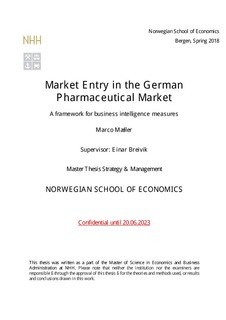Market entry in the German pharmaceutical market : a framework for business intelligence measures
Master thesis
Permanent lenke
http://hdl.handle.net/11250/2639078Utgivelsesdato
2018Metadata
Vis full innførselSamlinger
- Master Thesis [4372]
Sammendrag
Pharmaceutical companies today are under great pressure to successfully launch new
specialty drugs, high-tech products for small patient populations with cost intensive R&D
and complex mechanisms of effect.
At the same time, increasing privacy regulation limits the availability of data for market
research in the medical markets, forcing pharmaceutical companies to find ways of creating
transparency. Researchers can draw from a large, yet disperse body of literature investigating
the factors that favour early adoption of a drug.
The thesis introduces Roger’s Diffusion of Innovation framework to organize literature on
factors that speed up new product adoption among physicians. The framework is expanded
to suit the pharmaceutical markets, especially to differentiate between fixed variables and
such that are subject to change during an adoption process.
Afterwards different approaches to quantitative diffusion modelling are introduced with an
exemplary paper each. The different levels of modelling, from macro-level (national sales)
down to micro-level (individual behaviour) are explained. Subsequently, the limitations
through German privacy regulation as well as through market specific features on data
availability for pharmaceutical market research are presented. A comparison between
quantitative diffusion models on different levels with the current privacy regulation shows
which analysis approaches might still be feasible.
Based on the prior analysis, a quantitative model for drug adoption in the German
pharmaceutical market is developed, using Multiple Regression Analysis as the statistical
tool. It is found that under some conditions, a very simple two-variable model using the
salesforce visits’ and their assessment of a doctor’s adoption behaviour can explain more
than 40% of the variance in sales between hospitals. Limited availability of independent data
causes the model to be largely influenced through the sales force’s agenda in reporting.
Although this data is naturally biased, it seems unlikely that data availability from
independent sources will improve in the future. Pharmaceutical companies will need to
further utilize their sales force to collaborate with physicians and adapt their incentive
systems to live up to the new requirements.
